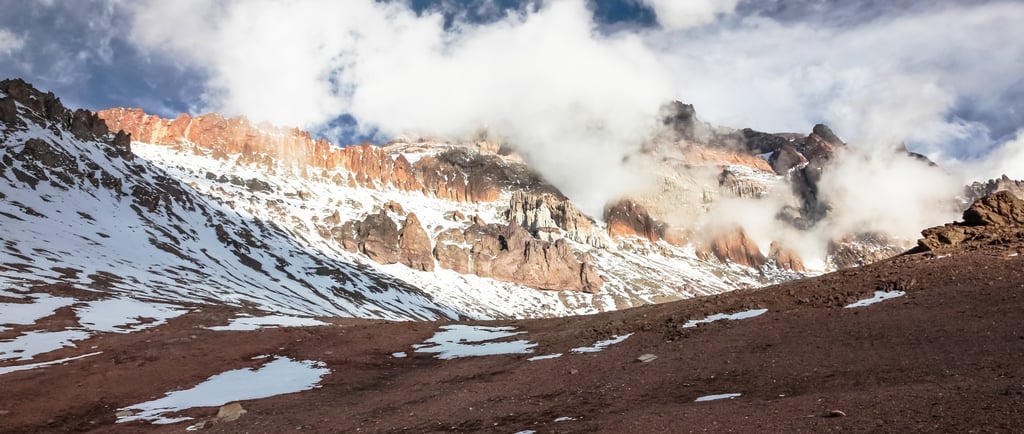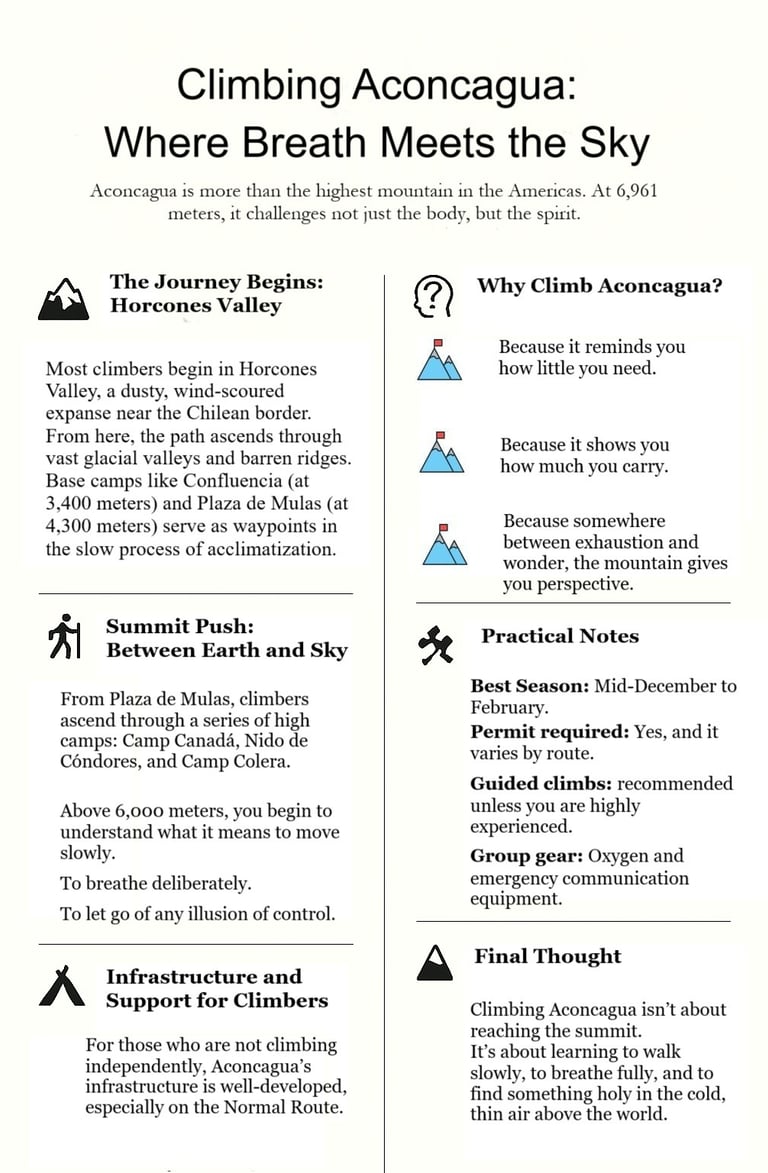Climbing Aconcagua: Where Breath Meets the Sky
Climbing Aconcagua is more than a summit—it's a slow, high-altitude reckoning with silence, breath, and self. Discover the route, rhythm, and support that shape this iconic Andes ascent.
ACONCAGUAPLACESMENDOZA
Gabriela Arellano
6/18/20253 min read


Towering above the Andes in western Argentina, Aconcagua is more than the highest mountain in the Americas. It is a place of reckoning, a journey that strips away noise and hurry until only the essential remains: breath, rhythm, silence.
Located in the province of Mendoza, at 6,961 meters, Aconcagua challenges not just the body, but the spirit. While it is considered a "non-technical" climb—meaning no ropes or ice axes are required on its most popular route—the demands of altitude, weather, and endurance make it one of the most formidable undertakings in South America.
🏞️ The Journey Begins: Horcones Valley
Most climbers begin in Horcones Valley, a dusty, wind-scoured expanse near the Chilean border. From here, the path ascends through vast glacial valleys and barren ridges. Base camps like Confluencia (at 3,400 meters) and Plaza de Mulas (at 4,300 meters) serve as waypoints in the slow process of acclimatization.
Each step forward is a negotiation with thin air. Acclimatization hikes, rest days, and the gradual surrender of comfort define the rhythm. Meals are functional. Sleep is light. Conversation softens. The mountain has begun to teach its lessons.
🧗 Summit Push: Between Earth and Sky
From Plaza de Mulas, climbers ascend through a series of high camps: Camp Canadá, Nido de Cóndores, and Camp Colera. These are places of cold, wind, and quiet resolve. Above 6,000 meters, you begin to understand what it means to move slowly. To breathe deliberately. To let go of any illusion of control.
Summit day is long—often 10 to 14 hours round trip. The wind can be brutal. The cold, biting. But those who endure are gifted with a view few will ever see: the Andes stretching in every direction, jagged and reverent.
At the top, there's no flag-waving or shouts of victory. Just stillness. A kind of internal hush. You don’t feel above the world—you feel within it.
💭 Why Climb Aconcagua?
Because it reminds you how little you need.
Because it shows you how much you carry.
Because somewhere between exhaustion and wonder, the mountain gives you perspective.
You come down changed—not triumphant but tuned. You’ve moved through something vast, and now, even your quiet is deeper.
🏔️ Final Thoughts
Climbing Aconcagua isn’t about reaching the summit.
It’s about learning to walk slowly, to breathe fully, and to find something holy in the cold, thin air above the world.
Aconcagua doesn't ask for conquest.
It offers a mirror.
And it speaks only in silence.
🏕️ Infrastructure and Support for Climbers
For those who are not climbing independently, Aconcagua’s infrastructure is well-developed, especially on the Normal Route. Several licensed tour operators based in Mendoza offer guided expeditions ranging from minimalist to full-comfort support. These packages often include:
Mules for gear transport to base camps
Meals and tents set up in advance at Confluencia and Plaza de Mulas
Medical checks and access to doctors at base camp
Professional guides trained in high-altitude rescue and wilderness first aid
Group gear, oxygen, and emergency communication equipment
Some operators also offer acclimatization extensions, private camps, and porter services for high camps. For climbers new to altitude or those seeking peace of mind, this kind of logistical support can make the difference between exhaustion and awe.
🛠️ Practical Notes
Best Season: Mid-December to February (southern hemisphere summer)
Permit Required: Yes, and it varies by route and nationality
Guided or Independent: Guided climbs are recommended unless you're highly experienced
Acclimatization: Non-negotiable. Allow 18–21 days for the full expedition
Closest City: Mendoza (with full outfitter services)


Explore more posts in our Travel category
Know Argentina
Discover diverse insights about Argentina's rich culture.
Connect
stay in the loop
info@knowargentina.com
© 2025. All rights reserved.
